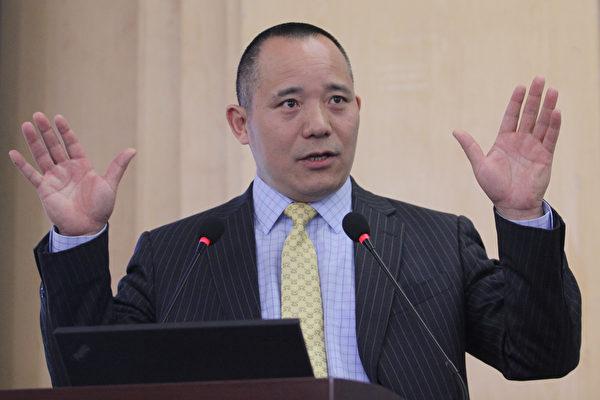On the eve of the 40th anniversary marking the start of the Chinese regime’s economic reform era, the country has been bearing the brunt of economic downturn amidst the Sino-U.S. trade war.
On Dec. 15, Xiang Songzuo, Deputy Director and Senior Fellow of the Center for International Monetary Research at China’s Renmin University delivered a speech detailing a series of problems afflicting the Chinese economy, including the country’s GDP growth.
Xiang challenged the figure given by the National Bureau of Statistics, which claims that China’s rate of GDP growth is at 6.5 percent. According to some researches, Xiang said, the real growth rate could be just 1.67 percent, while more dismal estimates say that China’s economy is actually shrinking.
In his speech, Xiang said that the Chinese regime leadership had made major miscalculations, especially in terms of the Chinese Communist Party’s (CCP) stance in the Sino-U.S. trade war. He criticized propaganda slogans aired by Party-controlled mass media, such as “The Americans are lifting rocks only to have them smash on their own feet,” “China’s victory is assured,” or “China will stand and fight” as being overly confident and ignorant of the real difficulty that the country faces.
Beyond the CCP’s stubborn attitude towards U.S. demands, a second cause for the recent downturn in the Chinese economy was the severe hit to private enterprises this year, Xiang said. Private investment and investments into private enterprises have slowed sharply, severely impacting confidence among entrepreneurs.
Various official statements implying the eventual elimination of private business and property have reduced private sector confidence. This includes the idea, put forward by some Party-backed scholars, that the market economy has already fulfilled its role and should retreat in favor of planned, worker-owned economics.
Xiang said: “This kind of high-profile study of Marx and high-profile study of the Communist Manifesto, what was that line in the Communist Manifesto? The elimination of private ownership—what kind of signal do you think this sends to entrepreneurs?”
Chinese law, social governance, and state institutions are rife with their own problems, he said. Xiang noted that even on the 40th anniversary of China’s “reform and opening up”—the term of the economic reforms started by former CCP leader Deng Xiaoping—current leader Xi Jinping still had to explicitly suggest greater protections for individual and corporate property.
Xiang said that a huge challenge for China is the Sino-U.S. trade war. He believes that it is no longer a trade war, but a serious conflict between the Chinese and American systems of values. The China-U.S. relationship is at a crossroads, he said, and so far there has been no solution found to resolve their differences.
In the short term, China faces drops in consumption across the board, from auto sales to real estate. Exports are also hard-hit due to the trade war and the gradual shift in the global supply chain.
Xiang criticized the Chinese regime’s reliance on increasing domestic consumption in order to keep the economy growing. Falling investment cannot be offset by consumption.
Throughout 40 years of market economic reforms, Xiang said, Chinese consumption patterns have demonstrated five phases. The first was to satisfy the demand for basic necessities like food and clothing; the second to satisfy demand for the “three new must-have items” (watches, bicycles, and radio sets); the third to supply non-essential consumer goods; the fourth to match demand for automobiles, and the fifth being real estate consumption.
Failing Enterprise and Impending Stock Crash
Xiang said that in the first three quarters of 2018 before October, corporate bond defaults have exceeded 100 billion yuan ($14.51 billion). According to official data, the corporate defaults will exceed 12 billion yuan ($1.74 billion) this year, while a large number of enterprises have gone bankrupt.Cao Dewang, a Chinese billionaire entrepreneur and the chairman of Fuyao, one of the largest glass manufacturers in the world, said that now a large number of enterprises have closed, as well as state-owned enterprises. Bohai Steel Group Company Limited, one of the world’s top 500 enterprises, went bankrupt. Its liability ratio reached 192 billion yuan ($27.86 billion).
Surging local Chinese government debt is another source of crisis. According to the National Audit Office, local authorities owed 17.8 trillion yuan ($2.58 trillion), but He Keng, deputy director of the Financial and Economic Affairs Committee with China’s National People’s Congress, said that the real figure is 40 trillion yuan (about $5.8 trillion).
Xiang warned that China’s poorly performing stock market has come to resemble conditions during the Wall Street Crash of 1929.
The devastating Wall Street stock market crash lasted for more than a decade, with most stocks falling 80 or 90 percent, Xiang said. The stocks of 83 firms fell by over 90 percent, 1,018 fell by over 80 percent, 2,125 by over 70 percent, and 3,150 by around 50 percent.
While unsound regulatory policy has exacerbated the problems, Xiang does not believe they are the underlying cause of the developing crash.
“Look at our profit structure,” he said. “Frankly speaking, China’s listed companies don’t really make money. Then who has taken the few profits made by China’s more than 3,000 listed companies? Two-thirds have been taken by the banking sector and real estate.The profits earned by 1,444 listed companies on the SME board and growth enterprise board are not even equal to one and half times the value of the Industrial and Commercial Bank of China. How can this kind of stock market become a bull market?”
Xiang made reference to a report comparing the profitability of Chinese and U.S. companies. American listed companies are in the billions, but among numerous Chinese tech and manufacturing companies, only one—Huawei—had profits in excess of $10 billion, but it was not a listed company.
The root problem concerning the Chinese economy, Xiang said, was that the majority of Chinese businesses rely on arbitrage, or taking advantage of price differences between markets, to make profits.
Official data claims that in the past ten years, IPOs (initial public offerings or stock market launches) have increased by more than 9 trillion yuan ($1.31 trillion), Xiang said. “Forty percent of it went to the stock market, speculation, and financial companies, but not investment into main businesses. Then can this be considered a good situation for listed businesses? Now you can say goodbye to the the equity pledges, game over.”
“I’m acquainted with many bosses of listed companies. Frankly speaking, quite a few of them didn’t use their equity pledge funds to do real business, but just play at arbitrage,” he said. “They have many tricks: our listed companies buy financial management firms and housing. The government makes official announcements saying that our listed companies invested one to two trillion yuan in real estate. Basically China’s economy is all dealing with virtual money, and everything is overleveraged.”
Short-term Monetary Policy and a Fundamental Dilemma
As the economic downturn pressure is huge, the authorities have resorted to their old methods: loosening monetary policy, employing radical credit schemes, loosening fiscal policies, and using radical capital policies, said Xiang.However, he thinks that the short-term adjustment of credit and currency cannot fundamentally solve the economic imbalances and gaps in development mentioned above.
“We are still trapped within the box of the old policy,” he said. “The key to whether transformation will be successful is the vitality of private enterprises—that is, whether policy can stimulate corporate innovation. We have been making a game of credit and monetary tools for so many years; isn’t this the reason we are saddled with so many troubles today? Speculation has driven housing prices so high.”
The core challenge facing private enterprises is not financing difficulty, though there are problems in this area, Xiang said. The fundamental problem is fear of unstable government policy.
“The leaders in the State Council said it clearly in the meeting of the Standing Committee: in China, the government is what can be least trusted. Therefore, in order to solve the debt problem, first, the debts that the government owes businesses need to be resolved, followed by the problem of of state-owned enterprises owing private enterprises, and then that of large private enterprises owing smaller ones,” he said.





Friends Read Free